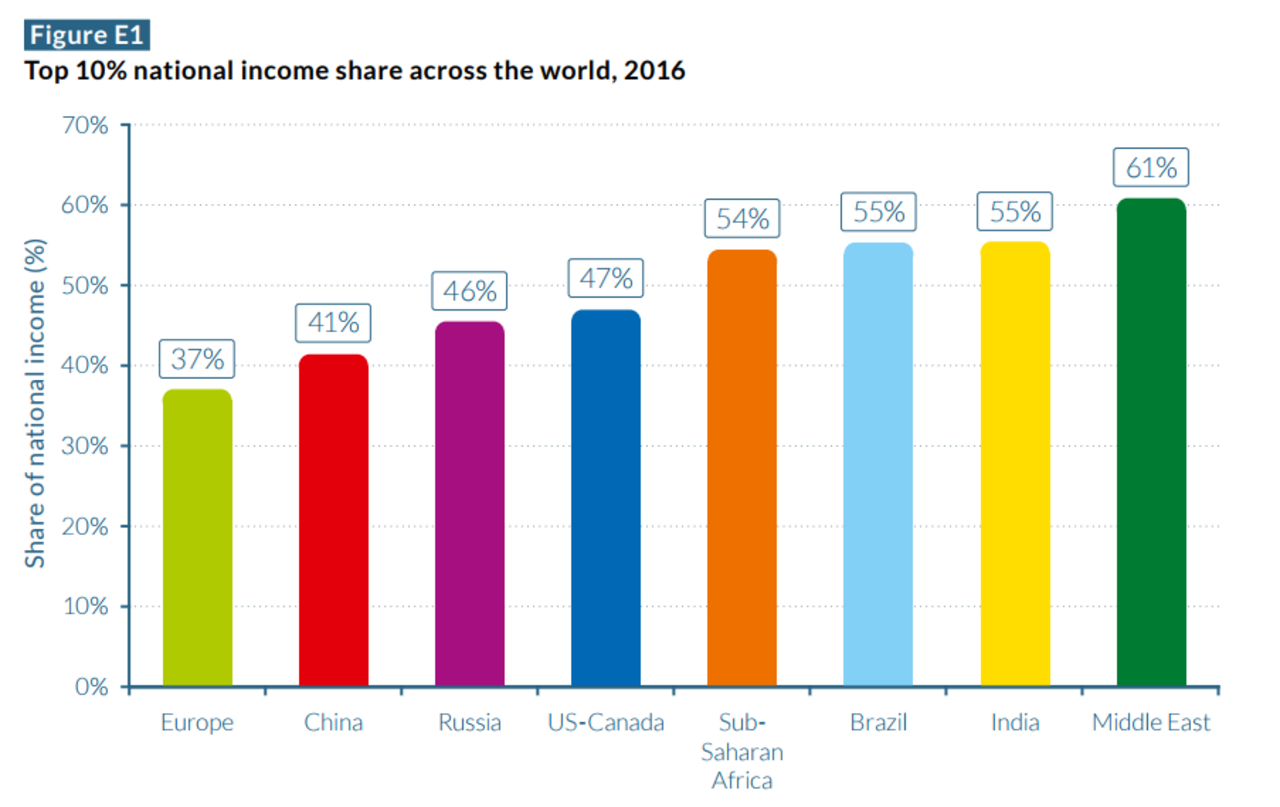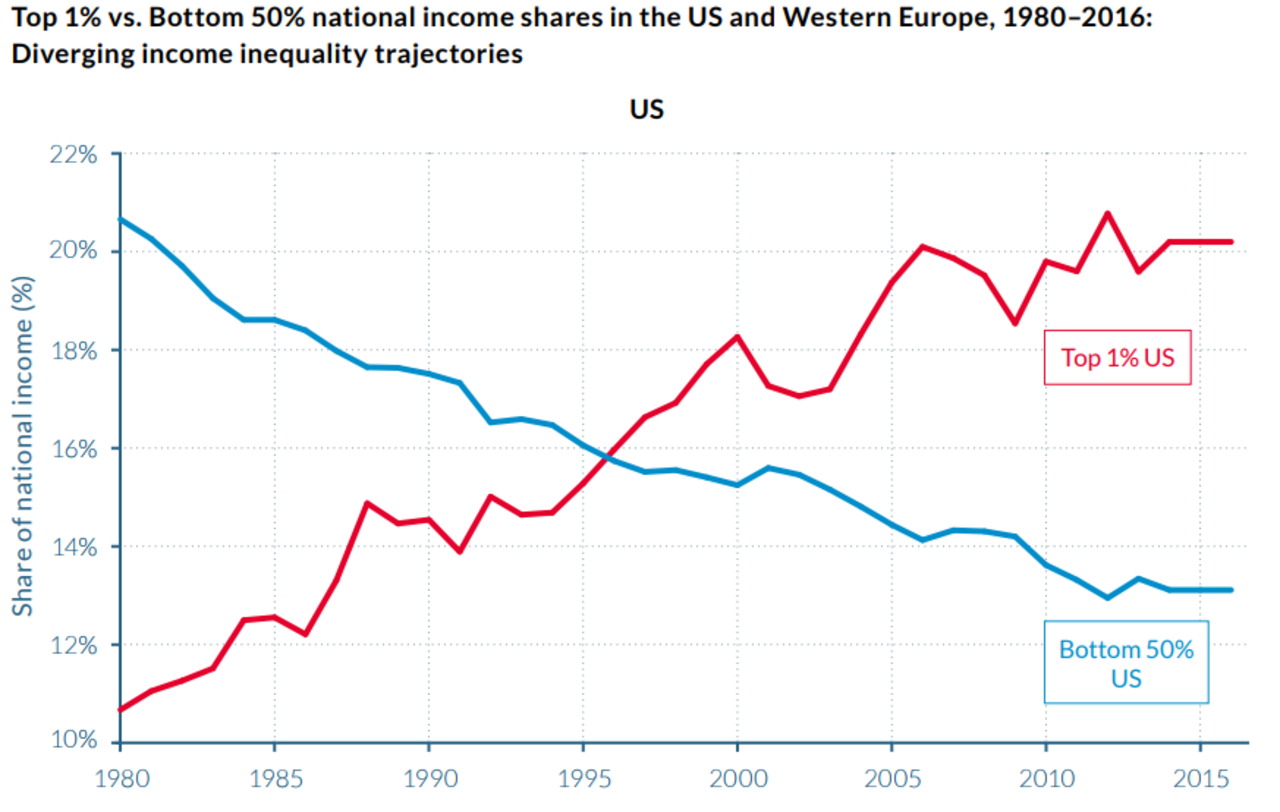The United States of Inequality
By Andre Damon
December 18, 2017 "Information Clearing House" - Last week, as Congress rushed to pass a tax bill that will transfer trillions of dollars to the financial oligarchy, two separate teams of experts published damning reports documenting the growth of social inequality in the United States.
On Thursday, a group of leading inequality researchers, including Thomas Piketty, Emmanuel Saez and Gabriel Zucman, published its 2018 World Inequality Report, which shows that the United States is far more unequal than the advanced economies of Western Europe, as well as much of the rest of the world.
The researchers reported that the income share of the top 1 percent of US income earners rose from 10 percent in 1980 to 20 percent in 2016, while the income share of the bottom 50 percent fell from 20 percent to 13 percent over the same period. The bottom 90 percent controls just 27 percent of the wealth today, compared to 40 percent three decades ago.
Another graphic indictment of American society was offered by Philip Alston, the UN special rapporteur on extreme poverty and human rights, who argued in a report published Friday that the prevalence of extreme poverty amid unimaginable opulence in the US is a violation of basic human rights.
The fact that the United States has invaded, bombed and destabilized countries all over the world on the pretext of defending “human rights” is no doubt one of the reasons the corporate-controlled media has chosen to bury both of these reports.
Alston writes of the “sewage filled yards in states where governments don’t consider sanitation facilities to be their responsibility,” of “people who had lost all of their teeth because adult dental care is not covered by the vast majority of programs available to the very poor,” and of “soaring death rates and family and community destruction wrought by prescription and other drug addiction.”
He notes that the extreme concentration of wealth has eroded the foundations of American democracy, writing: “There is no other developed country where so many voters are disenfranchised… and where ordinary voters ultimately have so little impact on political outcomes.”
In its Sunday edition, the New York Times published an editorial titled “The Tax Bill That Inequality Created.” The newspaper criticizes the bill being rammed through Congress for “lavishing breaks on corporations and the wealthy while taking benefits away from the poor and the middle class.” The editors add, “What many may not realize is that growing inequality helped create the bill in the first place.” A “smaller and smaller group of people” have become “in effect, kingmakers,” seeking to “bend American politics to serve their interests… rich families have supported candidates who share their hostility to progressive taxation, welfare programs and government regulation of any kind.”
The editors place the onus on Republicans, though they acknowledge that “donations from Wall Street and corporate America have… pushed many Democrats to the center or even to the right on issues like financial regulation, international trade, antitrust policy and welfare reform.”
There is a striking disconnect between the Times’ portrait of American society and its prescription, which, in the end, is to support the Democratic Party. The editorial concludes by hailing the election of right-wing Democrat Doug Jones in Alabama as proof that “inequality in America does not have to be self-perpetuating.”
The Times does not see fit to mention that in the 2016 elections it wholeheartedly backed a candidate, Hillary Clinton, who is completely beholden to “Wall Street and corporate America.” Nor does it recall that just last month it published an editorial declaring its full support for corporate tax cuts, the heart of the Republican tax plan. The Times wrote, “If Republicans worked with Democrats, they could reach a compromise to lower the top corporate tax rate.”
Entirely absent from the Times’ account is any explanation of why and how the United States has come to this point, or what the colossal levels of social inequality imply for the future of American society. This is because to do so would mean raising the question of the capitalist system itself, which the newspaper fervently supports.
The present situation did not arise from nowhere. Nor is it simply the product of the nefarious operations of one party. The emergence of oligarchic forms of rule, or “kingmakers,” is the product of a long historical evolution.
|
Never Miss Another Story |
The ideological foundations of 20th century American capitalism—the “American Dream,” the idea that the development of American capitalism would “lift all boats,” that each generation would be better off than the last—are now a distant memory.
During the first part of the last century, the American ruling class responded to the eruption of class conflict and the threat of socialist revolution, represented above all by the Russian Revolution, with social reforms—Roosevelt’s New Deal (including Social Security), increases in taxes on the wealthy, and the Great Society programs of the 1960s (including Medicare and Medicaid).
These measures, however, were implemented within the framework of preserving a social and economic system based on private ownership of the banks and corporations. Moreover, they were premised on the strength of American capitalism and its dominant position in the world economy.
The shift in ruling-class strategy corresponded with a shift in the position of American capitalism. Over the past half-century, the ruling class has sought to offset the decline in its economic position externally through military aggression and internally through the upward redistribution of social resources from the great mass of the population to the financial oligarchy. The results can be seen in the curve of social inequality, which shows the top one percent steadily amassing a greater share of wealth and income.
The trajectory has continued under both Democrats and Republicans. The Times editorial refers to the enormous growth of inequality over the past three decades. However, during this period Democrats occupied the presidency for 16 years (two terms for Clinton, two terms for Obama), compared to 12 years for Republicans (one term for Bush Sr, two for Bush Jr.). The processes of deregulation and financialization and the slashing of social programs have continued unabated, regardless of the political party controlling the White House and Capitol Hill.
All the institutions of American society have had their role to play in this social counterrevolution. The trade unions have transformed themselves into appendages of corporate management, relinquishing all claim to being “workers’ organizations.” During the 1980s, they isolated and suppressed every single strike or struggle against the onslaught of the rich. Today, they serve as cheap-labor contractors and industrial police for the ruling class, while providing comfortable sinecures for the upper-middle class functionaries that control them.
The Trump administration and its tax bill, far from being an aberration, are the continuation of this class policy.
The state of American society—to which ruling classes around the world look as a model—is a confirmation of Marxism. Capitalism is characterized by an irreconcilable conflict between the working class, the vast majority of humanity, and the ruling elite. The state is not a neutral arbiter, but an instrument of class rule. The working class must organize itself independently, with the aim of restructuring social and economic life.
The Democrats are no less terrified of this prospect than the Republicans. Hence the endless attempts to divert and disorient—from the anti-Russia campaign to the current hysteria over sexual harassment being promoted by the New York Times, among others.
When the Workers League in the US took the decision to form the Socialist Equality Party 22 years ago, it noted that the dominant feature in political life was “the widening gap between a small percentage of the population that enjoys unprecedented wealth and the broad mass of the working population that lives in varying degrees of economic uncertainty and distress.”
This analysis has been confirmed over the subsequent two decades. Just as the meteoric rise of social inequality is the inexorable outcome of the capitalist system, so too is the socialist transformation of society the only means to rid American and world society of the scourge of social inequality and the domination of the financial oligarchy, whose grip over social and economic life has become the principal obstacle to human progress.
This article was originally published by WSWS -
Copyright © 1998-2017 World Socialist Web Site
====
Join the Discussion
It is not necessary for ICH readers to register before placing a comment. This website encourages readers to use the "Report" link found at the base of each comment. When a predetermined number of ICH readers click on the "Report" link, the comment will be automatically sent to "moderation". This would appear to be the most logical way to allow open comments, where you the reader/supporter, can determine what is acceptable speech. Please don't use the report feature simply because you disagree with the author point of view. Treat others with respect, remembering that "A man convinced against his will, is of the same opinion still."- Benjamin Franklin. Please read our Comment Policy before posting -
|
|



